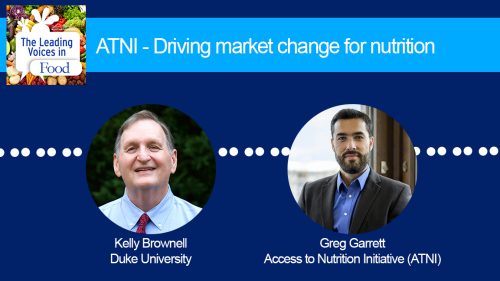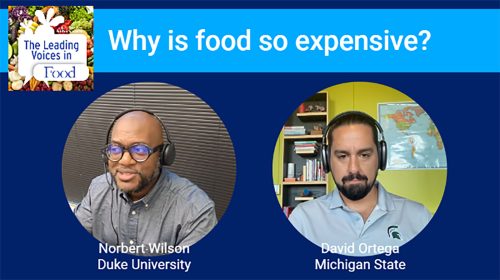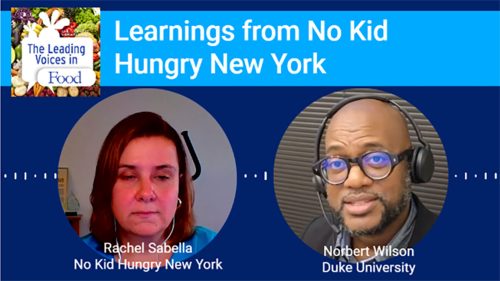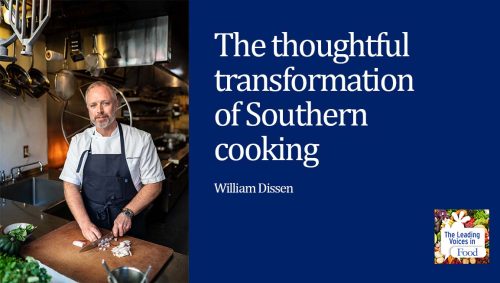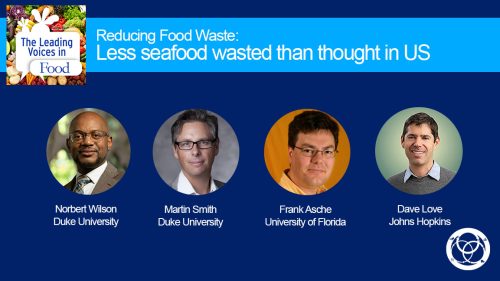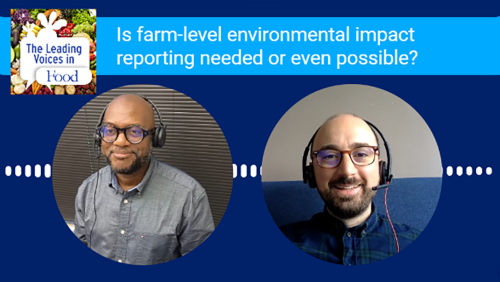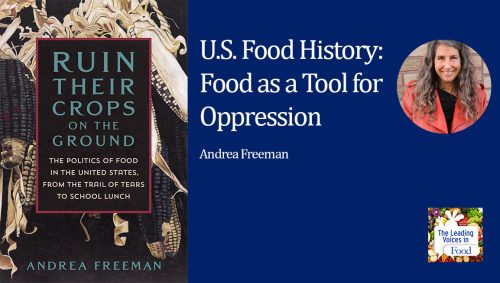The Leading Voices in Food
E229: From label to table: Regulating food in America
How did the Nutrition Facts label come to appear on millions of food products in the U.S.? As Auburn University historian, Xaq Frohlich, reveals in his new book, “From Label to Table: Regulating Food in America in the Information Age,” these seemingly innocuous strips of information reveal the high stakes politics that can help determine what we eat and why. In today’s podcast, Frohlich will explore popular ideas about food, diet, and responsibility for health that have influenced what goes on the Nutrition Facts panel and who gets to decide that.
Subscribe: Apple Podcasts | TuneIN | YouTube Music | SoundCloud | PocketCasts | Radio Public
Tags: Food Industry Behavior & Marketing | Food Policy | Food Safety & Food Defense | History & Food |

Xaq Frohlich is Associate Professor of History of Technology at Auburn University. He works on issues relating to food and risk at the intersections of science, law, and markets. His research focuses on the historical intersections of science, law, and markets, and how the three have shaped our modern, everyday understanding of food, risk, and responsibility. His work explores questions relating to consumerism and the changing relationships between the state, experts, and the public in the production of everyday knowledge: how do we “know” what we know about food and its relation to health? In what ways has our informational environment for food changed with the industrialization of food production and retailing? Frohlich earned his PhD in history, anthropology, and STS at MIT. He teaches courses on food and power, the intersections of science, technology and the law, and the history of business and capitalism.
Interview Summary
I’m really happy to have you on today’s podcast. So, why don’t we just jump right in. What would you say are the key historical moves in the food policy arena with respect to labeling?
One of the things I talk about in this book is an informational turn in food politics. And what I’m specifically referring to there is a shift since the 1970s from an older way that the Food and Drug Administration approached regulating the market to its current focus on informative labeling. So, at the beginning of my book and at the beginning of the story, in the 1930s, 1940s, the FDA was trying to handle this big market full of lots of different products, especially packaged and processed foods. And under the legislation in the 1938 Food, Drug, and Cosmetic Act, authorized food standards. And the idea was that for any mass-produced food, they would hold hearings. People would say, “This is what we think the food should look like.” They would then publish the standards, which would look kind of like a list of ingredients and ranges of the ingredients they could use, and then say, “Okay, all foods have to be the standard form of food. If not, we will either remove them from the market or call them imitation.” And this was a system they used for decades, and it created a lot of problems. Then, late 1960s people started to get unhappy about this. There was this big turning point connected to the White House Conference on Food, Nutrition and Health where Nixon administration brought together lots of nutrition scientists. And one of the conclusions that came out of that is we need to change the FDA’s system. And so, in the early 70s, the Food and Drug Administration says, “We’re going to pivot away from these food standards and start focusing on informative labels.” This is when you get the requirement of ingredient labeling on all foods, including standard foods, and you also get the first voluntary nutrition information label. My book looks at this change in strategies away from standardizing foods towards standardizing information about foods and creating these kinds of consumer-oriented information labels.
I love the fact that you helped us understand this idea of the information age, because once you read that and think, “Oh, well you’re talking about something about the internet,” but it’s even more foundational about how we communicate what is a product. I found it really fascinating to read in your book where you talked about what I perceive to be really laborious conversations around what exactly is peanut butter or some other product. I mean, it seems like that took up a lot of space. Do you think that was ultimately productive? Is that the reason why we see this information change? Or was there something important about that effort on its own?
So, there were advantages and disadvantages of the old food standards approach. One of the advantages is that everybody who wanted to raise an issue was invited to attend those hearings. This meant that you could have really colorful exchanges. There is one woman who ran a homemaker’s association who would show up and she would get a lot of attention because she was very colorful in her criticisms of proposed standards. It could be a very democratic space in that sense. On the other hand, they could run on for years. And there were contentious hearings where you would have dozens of lawyers from different food companies. It was held like a kind of legal court proceedings, and there would be objections, and counter evidence, and counter witnesses. One of the complaints in the 1970s is that this was another example of an overly burdensome centralized government agency and process that was expensive. And the switch towards using informative labels and moving away from food standards was seen to be a kind of lighter touch form of governance. The disadvantage is that now you have an even more backstage discussion about what goes on this label, and it means that consumers have even less access to who’s making those decisions for them.
Can you talk a little bit more about that? What’s in the backstage that we’re not privy to?
I think one of the misconceptions about the food label is that it is this window into the food, right? Especially something like nutrition and ingredients. You look at packaged food and you don’t know what you’re seeing, and therefore if they require the company to print the ingredients and nutrition, then you can look at that and now you have the kind of answer. In practice, it’s more complicated deciding what kind of information appears there, which nutrients do you want to do, how do you calibrate those in terms of the daily diet? Or how do you name the ingredients? Do you use the scientific name? Do you use the common name? Those questions are decided by people backstage. This could be FDA regulators. They could allow companies to make those decisions. And so, the label is actually a translation of those kinds of decisions. One of the arguments in my book is that you can’t get away from the values of these expert communities in deciding what goes on that label.
Yes, and thank you for that. I am really intrigued by how you are talking about the role of FDA, and I want to come back to that in a moment, this sort of panel of experts, and something that we think is so foundational, foods that we eat. We should know what they are. We believe we know what they are. They’re part of our larger history. But what I’m also hearing is actually government organizations mediate what we understand food is. I’m intrigued to learn some more. Given what you’ve learned about the history of food labeling, what do labels offer as a policy tool?
Often the way people see food labels is that is a kind of knowledge fix, especially with packaged foods. Because you don’t know what’s in them, there is this sense that there’s a kind of uneven playing ground between the producer and the consumer, right? The producer knows how it was produced. They know what’s in the food. They’re selling this to consumers and there’s concern that they might mislead the consumer. And so, this idea is that the label is a kind of technical solution to that market problem. And in many ways, it can work this way, but there’s actually a kind of translation work involved in there. It’s a more complicated story than just a knowledge fix. And in fact, a lot of studies that look at how people read ingredient labels, and especially nutrition labels, will talk about how they fail to understand this or that aspect of the nutrition label. Because consumers are dealing with decision fatigue, they’re in this, what people call the attention economy, where they don’t have a lot of time to look at labels. So often, reading the label is the least important part of food labels for policy. In fact, over and over again, in this history, I discovered that when the FDA was introducing changes to the food label, regulators and others would comment on how actually the biggest impact is that it would lead to companies changing the foods before. So, even if consumers aren’t reading the label, they’re affected by those changes because companies are reformulating the foods.
I’m really interested in that. I know that there is a body of literature that talks about this idea that by having to put the information out in the public, what you’re saying is companies reformulate because they want their products to look better, or maybe they actually are making the products better. Is that a fair assessment?
I think this is where you get into the tricky aspect of what we mean by better. So, taking the example of the nutrition label, one of the problems that you get with the beginning of nutrition labeling in the 1970s is it really favors a particular idea of what is better. So, if better means more of certain nutrients like protein or vitamins, and less of other nutrients like fats, or certain bad fats and sugars, then companies might reprocess a food, right? They’ll take out sugar. They’ll take out fat in it. And maybe they’ll add in other ingredients to make it taste good anyway. And they’ll kind of game that profile. And for people who are concerned about nutritional health in this sort of sense of nutrition, this might be great. But if your idea of good for you is less processed, you know this older idea of wholesome, you have this idea that the food was made in a kind of traditional sense, now you have a less good food. One of the problems that nutrition labeling raises is that it’s not that it’s misleading consumers, but it’s getting them to focus on certain attributes of the food and not thinking about other things that may be important for health.
That’s really helpful. I’m doing some work on date labels, and I’ve been thinking about this idea of how far can these labels go, and helping people make the best choices possible, however we define best. And that these labels are, as you said, the beginning. They’re definitely not the end of that decision or that process. So, this is a really a rich conversation. I want to ask you about misconceptions. What would you say is the biggest misconception about food labels from the point of view of consumers? You gave us a little bit of an idea about that, but I’d love to hear your thoughts on this.
One of the misconceptions about the food label is that it is this window into the food, right, especially something like nutrition and ingredients. When consumers receive this information label, they often take it at face value as sort of, “I now have this information about the food.” And therefore, if they require the company to print the ingredients and nutrition, then you can look at that and now you have the kind of answer. In practice, it’s more complicated. Deciding what kind of information appears there, which nutrients do you want to do, how do you calibrate those in terms of the daily diet? Or how do you name the ingredients? Do you use the scientific name? Do you use the common name? Those questions are getting decided by people backstage. This could be FDA regulators. They could allow companies to make those decisions. And so the label is actually a translation of those kinds of decisions.
One of my arguments is that you can’t get away from the values of these expert communities in deciding what goes on that label for the informative label. And in my book, I really try to argue that it’s not just a kind of conduit into the product. It’s not like suddenly you have the information. Instead, you need to read these labels as kind of value and political discussions among people who often have to make compromises. My favorite example of this with the nutrition facts panel was a decision to use the 2,000-calorie amount for daily values for the average American consumer. I remember interviewing a guy at the FDA, and I asked him about that, and he said, “Well, actually that’s not accurate.” It’s not like if you averaged out everyone’s caloric needs. Even in the 1990s, based on what they knew then, it would’ve been 2,000. For men, it was much higher. It was like 2,350. For women, it was lower. But they settled on 2,000 as a kind of pragmatic decision for multiple reasons. One, they hoped that if it was rounded, consumers wouldn’t think of it as like a precise tool and it would be easier to do math with. And also it was on the low end of what you should get. So, the idea was that this would discourage people from eating too much. So, they made all these kinds of compromises in it. But if consumers see this and they see it as a kind of science, then they tend to think it’s more rational than it really is.
And that’s the kind of thing I was most surprised about from doing this history was discovering that actually consumers aren’t reading these labels as rational calculators. They’re reading them emotionally. And the best example of this I got was interviewing Burkey Belser, who recently passed, and he was the head of the design firm that designed the nutrition box label. And he described it as a government brand. And he said, you know, “Seeing this thing everywhere, it’s not just about how people read it. It’s there in the background, kind of like brands and logos.” And it’s that emotional relationship to the information that I think policymakers really need to think about with labels, not just seeing them as a kind of rational decision-making device, but as something that is shaping consumers’ emotional decisions about the food they eat.
You’ve raised an important point for me, because I was going to ask, what do you think policy makers may be misunderstanding about these labels? I’m wondering, do policy makers understand these labels as a brand, a government brand? Are they capturing or dealing with the things that you’re just talking about, the emotional connection that consumers have with these products or these labels?
I think that one of the advantages of labeling, and I think this is why the FDA started looking at it more as an important tool in the 1970s, is that it’s a lot easier to focus on the package as a kind of site where you can police market behavior. So, it’s much easier to do that than to go into manufacturer’s factories to kind of say, “This is good, that is bad.” You can use it as a kind of accountability device. I think from the point of view of regulation in a big national and increasingly international market, that’s one of its advantages. The limitations of this for reforming food systems in my opinion, is it also ends up being a kind of outsourcing of work onto consumers, right? Instead of saying, “We want to make sure foods are safe and nutritious. We want to avoid certain kinds of ingredients or discourage certain kinds of unhealthy foods.” Governments are basically saying, “All right, we’re going to put it on the label and let the consumer do that work.” And I think that is one limitation of them. The other thing that I also think happens is it’s not just outsourcing to the consumers, but it’s also putting that in the market and using the market to solve those kinds of problems. And for mandatory labels, like the nutrition facts panel, this means that consumers who have the time and resources might end up adopting a healthier diet because of it. But many consumers who don’t have those kinds of choices aren’t going to be helped by this informative fix. For voluntary labels, and this is something I talk about at the end of the book. I call them lifestyle labels or risk labels, depending on what you’re talking about. So organic, carbon footprint labels, concerned about the environment, these kinds of third-party certificate labels, it becomes this kind of opt out. Instead of reforming the political system, you’re providing this kind of market upsell option for consumers to have those resources.
I’m intrigued to think about the FDA in its historical place. Your book provides a history of past FDA activities on food labeling, and you talked wonderfully about those already. How does it speak to current policy concerns at the FDA? And you were giving a little bit of an indicator of that with the front-of-pack labeling. I’m wondering are there other spaces about FDA concerns today?
I think if you’re really committed to reforming the food system, then food labels are only ever just the start to that reform work. They can’t be treated as the solution. And I think in the past you have had a lot of cases, particularly with public government, where the label is put forward as the kind of answer to a political problem. And then they don’t think about the need for staff to keep the education up about the label or enforcement. And so, they don’t treat it like the beginning of that reform work.
One of the things I find really exciting about what your book is doing, that you’re a historian and you’re talking about the development of this policy and it has important implications. What do you think history offers us in the current policy discourse? What do you bring to the table that we miss out by not talking with historians?
So, when I was doing this research, this event that I didn’t know happened that turned out to be really important in this story was this White House conference in 1969. At the time, the impetus for this conference was the sort of sudden public awareness of ongoing hunger in America. In the 1960s, people who were involved in civil rights realized that if they could focus on the issue of hunger, they could get a broader attention to problems of poverty and disparity in America. In 1968, this became a big public issue because of widely watched TV documentary. Everyone was talking about hunger and its connection to poverty and inequalities in America. And when the Nixon administration created the White House conference, the language of poverty and the concern of poverty was central. Then, there was a kind of shift over the course of the conference. Initially it’s talking about hunger and how that’s a malnutrition issue related to poverty. But by the end of the conference, they’re starting to focus on consumer education, better labels, better information. And in some sense, we haven’t got away from that framing shift. I really saw this recently with the Biden administration. It held its own White House Conference on Hunger, Nutrition and Health in 2022, and nowhere in its report was there a mention or discussion of poverty. They were really focused on foods as a vehicle for health, improving labels instead of talking about poverty as the kind of root concerns. Again, the kind of overall framing is if we engineer better foods in this nutritional sense, or we give you better information labels, then we’ll solve the health problems America’s facing. I think that that policy focus is ignoring the broader context of how Americans eat and how they’re making their decisions. So, I see my book as kind of providing a broader lens to think of the issues, not just historically, but also looking beyond sort of the field of nutrition or considerations of government, but looking at how these different institutions are all interacting with each other to shape policy. I think the two important things here are about what history can offer in present policy. One is that I actually think a lot of people working on these issues today have no idea where they came from. I’ve experienced this as I’ve given talks. I’ve had people in industry, or people who work on policies sort of say, “I didn’t realize that that was where the standard for milk came from,” when they were talking about recent changes in terms of the nomenclature for milk. Or “I didn’t understand that,” you know, “healthy, as it was defined in the 1990s, was in the context of one kind of health war, but today there’s a kind of new public health concern about other types of foods.” So, part of it is that I think that policymakers will really appreciate getting that older context. I often call it institutional memory because you lose that institutional memory. The other thing that’s really striking is, at the beginning of my story in the 1930s and 1940s, nobody was using words like saturated fats or carbohydrates. It was a different era and people were really talking about food differently. So, it’s useful. I think of it as like study abroad. You know, you go to this place, you see that people are talking very differently, and then you come back to your home country, you know, or the president, and you realize, “Oh,” you know, “there’s this aspect of food that I was taking for granted that has really changed in the last,” you know, “five, six decades.”


